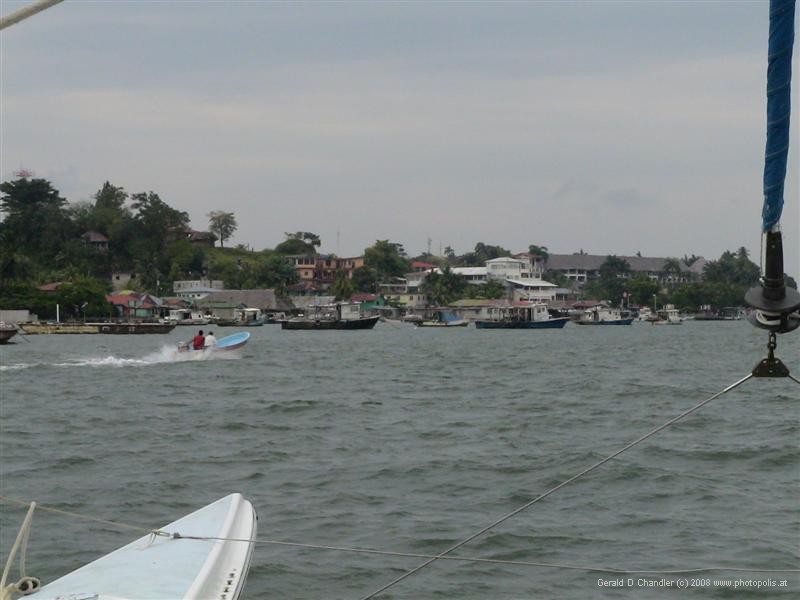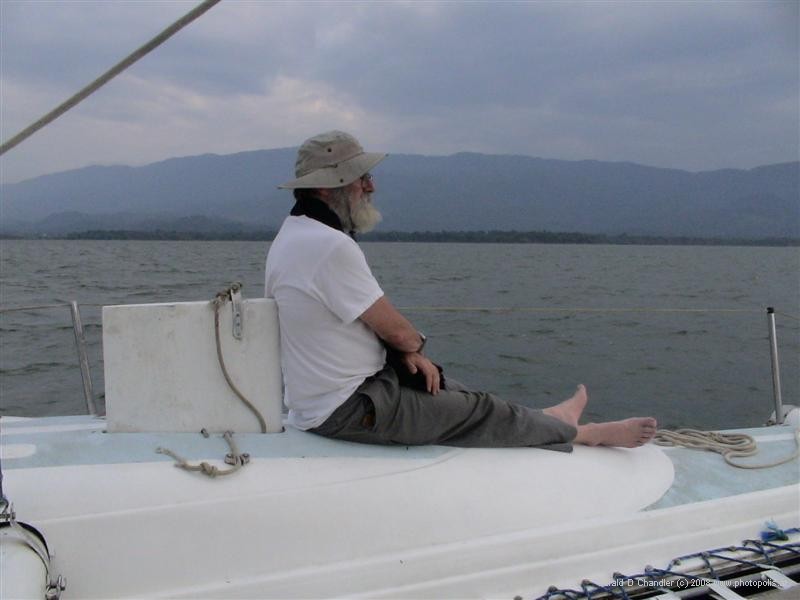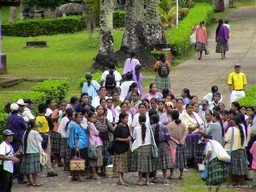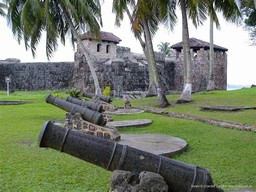Home | Front Page | Index | Blog | New | Contact | Site Map
Lake Peten Itza
Tikal
Coban
Guatemala City
Lake Atitlan
Markets
Antigua
Rio Dulce
Esquipulas
Mundo Maya
Foto Show

Central America
Route Maps
Belize
Honduras
Nicaragua
Costa Rica
Panama
Mexico 2003-04:

Bruno's Marina |
The town of Rio Dulce sits on the northern bank of the river Rio Dulce. Until the bridge connecting it to El Relleno village on the southern bank was opened around 1980 it was called Fronteras and crossing was by ferry (as we did at Sayaxche over the Rio Passion). At that time El Peten, the large, northern Guatemalan province, was truly a frontier. The number of paved kilometers of road was probably measured in two digits.
The Rio Dulce empties Lago de Izabal into the Caribbean, via a series of smaller lakes, narrower stretches, and finally what is called the Straights, which lead to Livingston. On the shores of Lago de Izabal, visible from the high arching bridge, is El Castillo de San Felipe, built in 1652 to protect settlers on the lake from pirates (mostly British) who would sail up the 30 km from the Caribbean. A guide at the Castillo said it was built there, rather than nearer the Caribbean because a natural point narrows the river, and it is closer to the settlers, who chose to be inland from the coast because it was much healthier than near the Caribbean.
As is probably clear by now, the big things to do in or from Rio Dulce are to kick back and enjoy nature, see the Castillo, and take a trip downriver to Livingston on the Caribbean. We managed all three.

Boarding our Catamaran |
We arrived in Rio Dulce from Quirigua in time for a late and much desired lunch. We chose LP's recommended Rio Bravo restaurant on the waterfront, which was okay, but it turned out to be one of the more expensive places in town. Thus it was a surprise that its internet was the cheapest (and always occupied for that reason).
Before we could get on to important things like relaxing we had to find a hotel. Being close, we walked over to Bruno's (also on the waterfront with several 40-60 ft yachts tied up in front, most registered in the USA) and found that it had the right price ($31/night), a balcony with a hammock and a charming view over the harbor, and a small swimming pool. That the room was a bit dumpy, and had a puddle outside of our front door, were of no major importance.
Late in the afternoon we found that the room next door was occupied by three Brits about half our ages. We soon learned that two of them were from London, visiting the third, who was working for a charity in Guatemala City helping homeless "street" children. We had been looking for a long time for a charity to which to donate some unneeded things. We gave her our tent, air mattress, and air pump that we'd bought to use in Yosemite and some clothes, shoes, and a few books.

Approaching Livingston |
We'd already made inquiries about boats to Livingston and had learned that a "collectivo" where you sit like a sardine and hear the roar of the outboard would cost Q150 ($19) round trip. On the other hand a private catamaran, Shin Tzu, was available at Q200 per person, with a minimum of four people. We proposed sharing it with the Brits, saying we thought we might get it for Q800 for all five, i.e. Q160 pp. They agreed to come along but when we went to arrange the trip the office was closed. Next morning it was raining at 7 a.m. so we gave up the idea of going. However, by 8:30 a.m. the rain had stopped and it looked like it might be a nice day. So off we went to the office and managed to strike a deal for a 9:00 a.m. departure, paying Q180 pp - a perfect compromise between their original asking price and our offer.
It was a great trip, there and back with only five of us (and two crew) to share a simple but spacious catamaran. On the way out we stopped to swim/sit in a sulfurous hot spring that flows into the lake/river close to the shore. Quite pleasant, if strange, to have hot water on one side and cold on the other. We saw some interesting birds but no crocodiles as we had seen on the Rio Passion. By the time we were nearly in Livingston we were all pretty hungry so Gerry passed around the McVitties Digestives which he had brought; seeing her precious, Belize-bought irreplaceable supply going into other mouths quite distressed Jan, but she grinned and bore it (and found more Digestives in Panama City). On the trip back we shared a watermelon that we had in reserve. Fortunately for Jan, this one did not attack her. Also on the way back we were supposed to sail but the wind was so weak that the crew motored. When we asked about sailing they put up the sails but still, because there was no wind to speak of, kept one outboard motor going.

The Ancient Mariner |
Livingston itself is the prototypical Caribbean fishing town, cleaned up for the tourists. Unlike the rest of Guatemala, its population is largely black, English-speaking, descended from slaves who revolted against the British. We ate a satisfying fish dinner and then walked the town from one end to the other in less than 15 minutes.
The next day we spent mostly on the balcony reading and enjoying the breeze, broken by visits to Bruno's pool and Bruno's restaurant. The following and our last day in Rio Dulce we walked to see Castillo San Felipe. Although less than a kilometer by water, it is nearly four kilometers by road. The countryside is pleasant but does not match LP's description of beautiful. Nearing the fort and its associated village we happened on Vinas del Lago, a nice hotel and restaurant with a fine view of the lake, and had a great meal there. That view and the ones we got later in the afternoon of the lake were all that we would get to know about Lago de Izabal. The other 100 km or so of shoreline will have to wait for later.

Local Visitors to the Fort |

Castillo de San Felipe |
Castillo San Felipe itself proved quiet interesting; we toured it with a group of four Americans/Canadians who had all been at intensive Spanish language school. Our understanding of the guide was perhaps slightly better than theirs. We walked back to town in moderate rain, our first in quite a while. It was built in about the same period as forts were at Campeche, Merida, and Bacalar, all in Mexico. Within a hundred years the pirates had been wiped out, largely because English politics changed and England had its own colonies to protect. Thus San Felipe fell into disuse, and, as seems to have been the typical custom, became a prison. A few centuries later all four mentioned places having suffered great decay, were restored and became tourist attractions. (A slight variation on this story is Castillo de San Marcos in Florida, also once a Spanish possession, which was used for military purposes into the 20th century.)